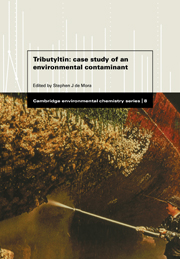Book contents
- Frontmatter
- Contents
- Contributors
- Preface
- 1 The tributyltin debate: ocean transportation versus seafood harvesting
- 2 Industrial manufacture and applications of tributyltin compounds
- 3 The analysis of butylated tin compounds in the environment and in biological materials
- 4 The occurrence, fate and toxicity of tributyltin and its degradation products in fresh water environments
- 5 The distribution and fate of tributyltin in the marine environment
- 6 Biological effects of tributyltin on marine organisms
- 7 TBT-induced imposex in neogastropod snails: masculinization to mass extinction
- 8 Environmental law and tributyltin in the environment
- 9 The efficacy of legislation in controlling tributyltin in the marine environment
- Index
4 - The occurrence, fate and toxicity of tributyltin and its degradation products in fresh water environments
Published online by Cambridge University Press: 04 August 2010
- Frontmatter
- Contents
- Contributors
- Preface
- 1 The tributyltin debate: ocean transportation versus seafood harvesting
- 2 Industrial manufacture and applications of tributyltin compounds
- 3 The analysis of butylated tin compounds in the environment and in biological materials
- 4 The occurrence, fate and toxicity of tributyltin and its degradation products in fresh water environments
- 5 The distribution and fate of tributyltin in the marine environment
- 6 Biological effects of tributyltin on marine organisms
- 7 TBT-induced imposex in neogastropod snails: masculinization to mass extinction
- 8 Environmental law and tributyltin in the environment
- 9 The efficacy of legislation in controlling tributyltin in the marine environment
- Index
Summary
Introduction
The chemistry and toxicity of tin and organotin compounds have been extensively reviewed (e.g., Blunden and Evans, 1990; Maguire, 1987, 1991; World Health Organization, 1990; and references therein). The major uses of organotin compounds are as poly(vinyl chloride) (PVC) stabilizers, industrial catalysts, industrial and agricultural biocides, and wood preserving and antifouling agents. From an environmental point of view, tributyltin compounds used as antifouling agents are of most concern because of their extremely high toxicity to aquatic organisms. This chapter reviews the occurrence, persistence and toxicity of tributyltin, and its degradation products dibutyltin and monobutyltin, in fresh water environments.
Sources and environmental occurrence
The main use of tributyltin compounds, with direct introduction to water, is as antifouling agents. However, there are other pesticidal uses. In Canada, for example some tributyltin-containing pesticides are also registered for use as material preservatives, joinery wood preservatives, remedial wood preservatives, wood preservative stains, and as slimicides. In some parts of Africa, tributyltin compounds have been applied directly to water in the control of schistosomiasis, and they are used agriculturally against cotton-boll worms (Aboul Dahab, El-Sabrouti and Halim, 1990).
Butyltin species are not produced biologically, and therefore their environmental presence is due to anthropogenic input. In general the occurrence of butyltin species in the environment is a result of the use of tributyltin as an antifouling agent. However, the finding of tributyltin in a power plant discharge in Italy (Gabrielides et al., 1990), and in sewage treatment plant influents and effluents in Switzerland (Fent and Muller, 1991) and Canada (Chau, Zhang and Maguire, 1992) probably reflects slimicidal uses of tributyltin.
- Type
- Chapter
- Information
- TributyltinCase Study of an Environmental Contaminant, pp. 94 - 138Publisher: Cambridge University PressPrint publication year: 1996
- 9
- Cited by



